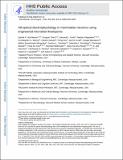All-optical electrophysiology in mammalian neurons using engineered microbial rhodopsins
Author(s)
Hochbaum, Daniel R; Zhao, Yongxin; Farhi, Samouil L; Werley, Christopher A; Kapoor, Vikrant; Zou, Peng; Kralj, Joel M; Maclaurin, Dougal; Smedemark-Margulies, Niklas; Saulnier, Jessica L; Boulting, Gabriella L; Straub, Christoph; Melkonian, Michael; Wong, Gane Ka-Shu; Harrison, D Jed; Murthy, Venkatesh N; Sabatini, Bernardo L; Campbell, Robert E; Cohen, Adam E; Klapoetke, Nathan Cao; Cho, Yongku; Boyden, Edward; ... Show more Show less
DownloadBoyden_All-optical electrophysiology.pdf (2.090Mb)
OPEN_ACCESS_POLICY
Open Access Policy
Creative Commons Attribution-Noncommercial-Share Alike
Terms of use
Metadata
Show full item recordAbstract
All-optical electrophysiology—spatially resolved simultaneous optical perturbation and measurement of membrane voltage—would open new vistas in neuroscience research. We evolved two archaerhodopsin-based voltage indicators, QuasAr1 and QuasAr2, which show improved brightness and voltage sensitivity, have microsecond response times and produce no photocurrent. We engineered a channelrhodopsin actuator, CheRiff, which shows high light sensitivity and rapid kinetics and is spectrally orthogonal to the QuasArs. A coexpression vector, Optopatch, enabled cross-talk–free genetically targeted all-optical electrophysiology. In cultured rat neurons, we combined Optopatch with patterned optical excitation to probe back-propagating action potentials (APs) in dendritic spines, synaptic transmission, subcellular microsecond-timescale details of AP propagation, and simultaneous firing of many neurons in a network. Optopatch measurements revealed homeostatic tuning of intrinsic excitability in human stem cell–derived neurons. In rat brain slices, Optopatch induced and reported APs and subthreshold events with high signal-to-noise ratios. The Optopatch platform enables high-throughput, spatially resolved electrophysiology without the use of conventional electrodes.
Date issued
2014-06Department
Massachusetts Institute of Technology. Department of Biological Engineering; Massachusetts Institute of Technology. Department of Brain and Cognitive Sciences; Massachusetts Institute of Technology. Media Laboratory; McGovern Institute for Brain Research at MITJournal
Nature Methods
Publisher
Nature Publishing Group
Citation
Hochbaum, Daniel R; Zhao, Yongxin; Farhi, Samouil L; Klapoetke, Nathan; Werley, Christopher A; Kapoor, Vikrant; Zou, Peng et al. “All-Optical Electrophysiology in Mammalian Neurons Using Engineered Microbial Rhodopsins.” Nature Methods 11, no. 8 (June 2014): 825–833 © 2014 Rights Managed by Nature Publishing Group
Version: Author's final manuscript
ISSN
1548-7091
1548-7105